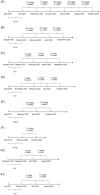Systemic bevacizumab for pediatric patients with aggressive recurrent respiratory papillomatosis: One single-center experience of eight patients
- PMID: 37090874
- PMCID: PMC10116968
- DOI: 10.1002/lio2.1013
Systemic bevacizumab for pediatric patients with aggressive recurrent respiratory papillomatosis: One single-center experience of eight patients
Abstract
Recurrent respiratory papillomatosis (RRP) is a human papilloma virus (HPV)-driven benign neoplasm, affecting larynx, trachea, and even lung, leading to voice disorders, airway obstruction, and postobstructive pneumonia. Several case reports have documented the promising efficacy of intravenous bevacizumab in reducing the need for surgical intervention among RRP patients. Herein, we present our experience on systemic bevacizumab for pediatric patients with aggressive RRP.
Methods: We retrospectively analyzed clinical, laboratory, radiological, and bronchoscopy findings of pediatric patients with aggressive RRP treated with systemic bevacizumab from July 26, 2021 to March 1, 2022.
Results: Eight consecutive patients were included. Median age at treatment initiation was 5.5 (range 2.5-8) years old. Twenty-five percentage (2/8) of patients experienced tracheotomy. Pulmonary papilloma was present in 62.5% (5/8) patients. Patients received median 10 cycles of bevacizumab (range 5-12). Patients received initial dosing of 4-7.5 mg/kg every 2-10 weeks of bevacizumab and subsequently extended after achieving the maximum response. None of the patients required surgical intervention during a median 10 (range 8.2-15.4) months follow-up after initiating bevacizumab treatment. Both patients with evaluable lung lesions showed objective response. Only Grade 1 abdominal pain and Grade 1 hyperuricemia were recorded.
Conclusion: Systemic bevacizumab seems to be a well-tolerated and effective treatment option for pediatric patients with aggressive RRP.
Keywords: bevacizumab; efficacy; pediatrics; recurrent respiratory papillomatosis; safety.
© 2023 The Authors. Laryngoscope Investigative Otolaryngology published by Wiley Periodicals LLC on behalf of The Triological Society.
Conflict of interest statement
The authors declare no conflict of interest.
Figures


Similar articles
-
Aggressive recurrent respiratory papillomatosis: A series of five consecutive patients successfully treated with adjuvant intravenous bevacizumab. A single Belgian academic center experience.Head Neck. 2023 May;45(5):1071-1079. doi: 10.1002/hed.27300. Epub 2023 Feb 25. Head Neck. 2023. PMID: 36840929
-
Long-Term Follow-Up on Systemic Bevacizumab Treatment in Recurrent Respiratory Papillomatosis.Laryngoscope. 2021 Jun;131(6):E1926-E1933. doi: 10.1002/lary.29351. Epub 2020 Dec 31. Laryngoscope. 2021. PMID: 33382105
-
Systemic bevacizumab for recurrent respiratory papillomatosis: A national survey.Laryngoscope. 2017 Oct;127(10):2225-2229. doi: 10.1002/lary.26662. Epub 2017 Jun 28. Laryngoscope. 2017. PMID: 28657692 Free PMC article.
-
Recurrent laryngeal papillomatosis: multimodal therapeutic strategies. Literature review and multicentre retrospective study.Acta Otorhinolaryngol Ital. 2023 Apr;43(Suppl. 1):S111-S122. doi: 10.14639/0392-100X-suppl.1-43-2023-14. Acta Otorhinolaryngol Ital. 2023. PMID: 37698108 Free PMC article. Review.
-
Systemic bevacizumab as adjuvant therapy for recurrent respiratory papillomatosis in children: A series of three pediatric cases and literature review.Am J Otolaryngol. 2021 Sep-Oct;42(5):103126. doi: 10.1016/j.amjoto.2021.103126. Epub 2021 Jun 24. Am J Otolaryngol. 2021. PMID: 34175693 Review.
Cited by
-
"A systematic literature review of the epidemiology, clinical, economic and humanistic burden in recurrent respiratory papillomatosis".Respir Res. 2024 Dec 18;25(1):430. doi: 10.1186/s12931-024-03057-w. Respir Res. 2024. PMID: 39696284 Free PMC article.
References
LinkOut - more resources
Full Text Sources
